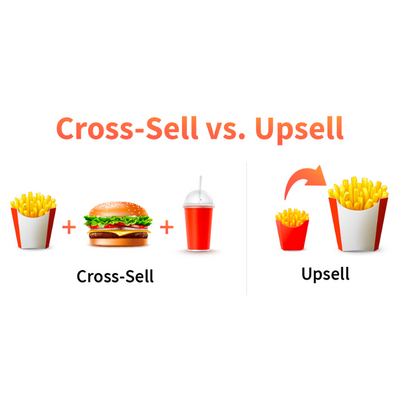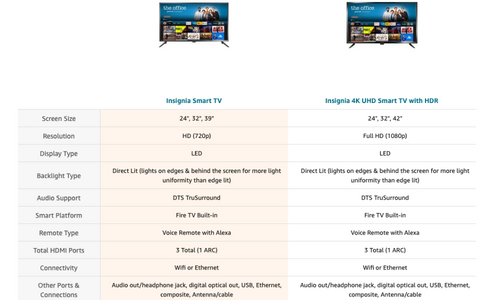A Guide to Upselling on Amazon
There are numerous pricing and selling strategies in eCommerce. It is important to find the right one for your store in order to build a sustainable business.
To help you with this step, we’ve created a guide to Upselling on Amazon.
What is Upselling?
Upselling is a sales strategy you can use to persuade the customer to buy more expensive items or upgrades to increase the order value. In other words, it is about getting the customer to purchase a product that is more expensive than what the customer originally wanted to buy.
For example, if a customer is looking at a $500 TV, you can show them an Upsell offer for a $700 TV with more features and better quality.
Difference to Cross-Selling
As with Upselling, Cross Selling refers to an additional expenditure by the customer. The difference, however, lies in the type of products sold. Whereas Upselling usually involves selling higher-quality, more expensive or better-equipped products, Cross Selling is about buying products that could also fit or extend the intended use.
With Cross Selling, the customer does not originally intend to buy an additional item, but will still buy it if you make a reasonable suggestion. With Upselling, on the other hand, the customer already has the intention to buy a certain product and is enticed by the seller to choose a higher-quality and more expensive product.
The difference is illustrated clearly in this picture:

Advantages of Upselling
The fact that the customer has internally already made a fundamental purchase decision can have a great impact on increasing sales without incurring additional costs for customer acquisition.
With Upselling, you also have the advantage of being able to address emotional buying motives. Since higher-priced products often symbolise prestige, you can often encourage customers to make an emotional purchase decision if they are offered a higher-quality product for a manageable extra charge.
Likewise, you can achieve higher customer satisfaction with Upselling. Since you have offered a higher-quality product for argument’s sake, side effects such as customer loyalty and referrals can arise.
Usually, customer loyalty costs much less than acquiring new customers. After all, if customers are suggested the appropriate products based on their buying behaviour during Upselling, they will return to your store again and again due to their satisfaction. Upselling therefore often leads to increased customer lifetime value (CLV).
Potential risks in Upselling
The biggest risk in Upselling is distracting the potential customer too much and thus keeping him from making the planned purchase. A major risk is also that the customer will be sustainably irritated and therefore cancel their buying process, remembering what they see as the seller’s intrusive behaviour.
Accordingly, it is always important to choose, analyze and optimise the product selection for Upselling carefully and, above all, aptly. Possible risks should always be weighed up in this process.
How you can successfully implement Upselling
When Upselling, it is important to always keep the customer’s needs and wants in mind. You should adapt your offers to these preferences.
Since most customers have already set a certain budget for a product, it is important to clearly highlight the advantages of the more expensive alternative. If these advantages are clear to the customer, he or she is more willing to extend their budget and buy the more expensive product.
It’s equally important to keep in mind that Upselling is not about forcing an unwanted product on the customer. It’s just about upgrading a product they already want to buy. You should point to this upgrade with rational arguments.
The goal of Upselling is to increase profits. In order to actually achieve this, you should thoroughly calculate the use of Upselling strategies in advance. This will help you determine whether Upselling could be worthwhile, or whether you could make more profit by selling the simple product version and Cross Selling at the same time.
The right advertising measures also contribute to your success. With Sponsored Ads, you can increase your visibility enormously and reach more customers. As a PPC tool, BidX can help you manage these ads, so you can take care of other aspects of upselling.
Where to use Upselling
On Amazon, there are various ways and models to use Upselling. For example, Upselling takes place indirectly through automatically-generated product ads and links. These are listed for most Amazon products under “Customers who bought this item also bought”, “Sponsored products”, or “What other items do customers buy after seeing this item?”. It should be noted, however, that the boundaries between Upselling and Cross Selling are often not clear in these cases.

Upselling on Amazon with Sponsored Products for TVs
Furthermore, Upselling can be found in the automatically generated product comparison tables. In these lists, different models from different brands are compared with each other. However, as a merchant, you have no direct influence on the table and thus cannot influence whether your product is placed in the list or not.

Upselling on Amazon with Product Comparison Table for TVs
With A+ content, on the other hand, vendors have the possibility to create their own comparison table. This allows them to offer the customer a higher-quality product variant, as well as to choose the comparison criteria and selection of products themselves.
However, for sellers, this option is only available if they register their brand at Amazon. Comparison tables are usually an effective method of highlighting the differences and advantages relevant to the customer. However, it is important to keep the table relatively simple in order to avoid confusing the customer.

Upselling on Amazon with A+ Content for TVs
Additional tips for effective Upselling
1. Understand your audience
To make product recommendations as fitting as possible, you should thoroughly analyse the customer information you have.
Here it can also be helpful to think about possible problems the customer may have and offer a solution to that problem in the form of your product.
2. Narrow down the selection for an Upsell
You should limit the product selection so that you do not confuse the customer and thus discourage a purchase.
3. Be helpful, not pushy
As previously mentioned, you should be adding value to the customer, not pushing a product on them. Upselling should serve to help the customer achieve their goals. You can help the customer by providing relevant product recommendations and ensuring customer satisfaction.
4. Limit the price increase
Since it is highly likely that the customer already has a certain budget for a purchase, you should be careful not to go too far beyond this limit. When Upselling, the recommended product should of course be more expensive than the basic product, but not more than 25-40%.
5. Make Upselling your standard practice
Upselling can be a good and even long-term way to increase your sales. However, it is important that you perfect this method. Regular training for your sales staff is a great way to do this.
This can be beneficial for both customers and your company. Customers get relevant product suggestions with a well-developed upsell and can effectively reach their purchase goals. For your business, you have the advantage of gaining loyal and returning customers and increasing lifetime value and revenue.
The bottom line
If you pay attention to all the important aspects and personalise the product recommendations for your customers, you can have great success with Upselling on Amazon.
In order to successfully upsell, advertisements are especially helpful. In most cases, you need to use advertisements to display your recommended products on other product detail pages. To efficiently manage your ads, a PPC management tool like BidX can help.
BidX continuously analyzes the performance of your ads with self-learning algorithms and makes your ads more profitable through bid and keyword adjustments. This saves you valuable time and resources and gives you more time for your core business.
If you are interested in advertising on Amazon, please book a meeting with us!
Author’s Bio:
Lena Trapp is Marketing Manager at BidX. BidX supports Amazon sellers with software solutions that automate and optimize advertising on and off Amazon.
